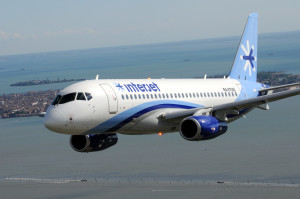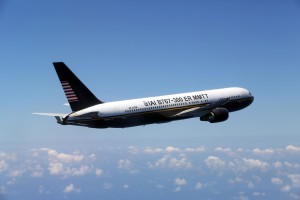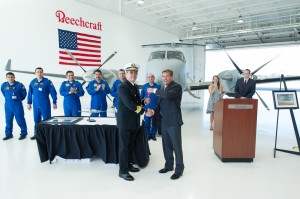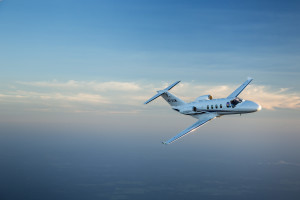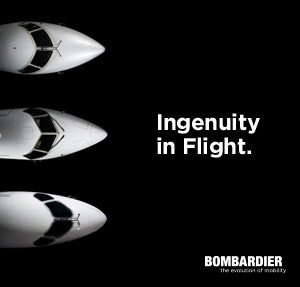Embraer produz primeira peça dos E-Jets E2
October 17, 2014
Évora, Portugal, 17 de outubro de 2014 – A Embraer realizou nesta sexta-feira, na sua Unidade em Évora, em Portugal, a produção da primeira peça dos E-Jets E2, segunda geração da família de aviões comerciais E-Jets. A peça faz parte do conjunto do caixão central da asa (wing stub), sendo uma caverna de pressão entre o stub e a fuselagem do primeiro protótipo do jato E190-E2, cujo primeiro voo está programado para 2016.
“A produção desta primeira peça, no prazo estipulado, é um marco importante em todos os programas de aviação, pois representa a transição entre o projeto e o início da fabricação dos aviões”, disse Paulo Cesar Silva, Presidente & CEO da Embraer Aviação Comercial. “Ainda há um longo caminho a percorrer até a entrada em serviço, mas não temos dúvida de que entregaremos ao mercado a aeronave mais eficiente, moderna e robusta do segmento, além de muito confortável para os passageiros.”
A caverna de pressão dianteira é feita de alumínio aeronáutico e foi fabricada em um dos modernos centros de usinagem de alta velocidade da fábrica de estruturas metálicas em Évora e seguirá para a montagem do conjunto no Brasil.
A Embraer anunciou a escolha de Évora para abrigar as fábricas Embraer Compósitos e Embraer Metálicas em 2008, inaugurando as mesmas em setembro de 2012. A montagem final dos jatos E2 e o processo de entrega aos clientes serão realizados na sede da Embraer em São José dos Campos, nas mesmas instalações utilizadas para a fabricação da atual geração de E-Jets.
A primeira entrega de um E-Jet E2 (o E190-E2) está prevista para o primeiro semestre de 2018. O E195-E2 está programado para entrar em serviço em 2019 e o E175-E2, em 2020. O programa E-Jets E2 reforça o compromisso da Embraer em continuamente investir na linha de jatos comerciais da Empresa e manter sua liderança de mercado no segmento de 70 a 130 assentos. Motores de última geração, em conjunto com novas asas aerodinamicamente avançadas, controles de voo totalmente fly-by-wire e avanços em outros sistemas resultarão em melhorias significativas no consumo de combustível, custos de manutenção, emissões e ruído externo.
Embraer Aviação Executiva exibe Legacy 450 pela primeira vez na NBAA
October 16, 2014
Melbourne – Flórida, EUA, 14 de outubro de 2014 – A Embraer Aviação Executiva exibirá sua linha completa de produtos na Convenção da Associação Nacional de Aviação Executiva (NBAA, na sigla em inglês) em Orlando, Flórida, de 21 a 23 de outubro. Esta será a primeira vez que a Empresa apresentará as sete aeronaves em exposição estática, incluindo um protótipo do jato Legacy 450, da categoria mid-light, que tem certificação prevista para meados de 2015.
“Estamos muito empolgados por trazer o Legacy 450 para a NBAA junto com o Legacy 500, que foi entregue ao primeiro cliente na semana passada”, disse Marco Túlio Pellegrini, Presidente da Embraer Aviação Executiva. “Estas aeronaves são revolucionárias, introduzindo verdadeira inovação em suas classes”.
A Empresa realizará uma coletiva de imprensa no dia 20 de outubro, das 11h às 11h45, na sala N220A do centro de convenções de Orange County e recepcionará clientes e visitantes no estande de número 5638. O portfólio da Embraer Aviação Executiva estará em exposição estática na área 655 do aeroporto executivo de Orlando.
The SSJ100 Marks 1 year of Operations with Interjet
October 1, 2014
Barcelona, ERA General Assembly – October 1, 2014
The Sukhoi Superjet 100 aircraft celebrates its first anniversary of operations with Interjet. On September
18, 2013 the first SSJ100 entered into service with the Mexican airline.
Up to the anniversary date, the Interjet fleet logged more than 12.000 flight hours and 11.400 flight cycles.
The maximum utilization in a day was over 11 flight hours.
Starting from the EIS, the Interjet SSJ100 fleet has confirmed outstanding results in terms of
performance in the typical high-altitude environment of Mexico.
According to the airline’s operational reliability report, the SSJ100 is showing a technical dispatch
reliability’s average of 99%. In 1 year of operations, the Interjet SSJ100 fleet hasn’t logged any
cancellations due to technical reasons.
The current fleet of nine SSJ100 aircraft in service is operated from Mexico City to various Mexican
destinations, such as Torreon, Tijuana, Puerto Escondido and Acapulco. The longest flight performed
was Mexico City(MEX) – Tijuana(TIJ) of 3 flight hours and 09 minutes.
The fleet leader is the first delivered SSJ100 (MSN 95023), which logged more than 2400 FH and 2300
FC starting from the EIS in September 18, 2013.
“We are very proud of these operational results – states Nazario Cauceglia, CEO of SuperJet
International – they confirm that the SSJ100 is a competitive product and offers in today’s market the
Superior Aviation Group appoints Ana Fontes Director International Business Development
September 15, 2014
Ms. Fontes will be responsible for developing international business opportunities
for the Superior Aviation Group companies, including coordinating sales and development efforts for the recently announced Superior Aviation Town project.
Coppell, TX, September 14, 2014 — Timothy T. (Tim) Archer, Group CEO, of the Superior Aviation Group announced today that Ana C. Fontes has been appointed as the Group Director of International Business Development.
“The Superior Aviation Group of companies has been enjoying continued success and we are now ready to begin growing into global markets,” Archer stated. “Ana’s considerable experience with the international aspects of the general aviation industry and her multi-lingual, multi-cultural background will be a tremendous asset as we initiate those efforts.”
“Ana’s current responsibilities of representing the Group’s Flagship company, Superior Air Parts in Brazil, will not only be absorbed, but be expanded to include the rest of the world,” he said. “In addition, she will be heavily involved with identifying and coordinating our efforts with prospective tenant companies interested in participating in the exciting new Superior Aviation Town and Executive Airport development project.”
“This is an extremely exciting opportunity and I could not be more appreciative of the confidence that the Group has shown in my abilities,” Ms. Fontes said. “This new position will allow me to fully utilize my experiences in and enthusiasm for not only identifying the growth opportunities found in today’s global aviation markets, but developing ways to maximize their potential for our Group companies.”
Prior to her recent appointment, Ms. Fontes was the Brazilian sales and marketing representative for Superior Air Parts, Inc., a member of the Superior Aviation Group. Before starting her own company, Fontes Marketing Consulting, which specializes in helping U.S.-based companies open new markets in Brazil and South America, she served as Corporate Marketing and Americas Sales Director for Mistral Engines, S.A.
Ms. Fontes is also the Director of International Affairs for AOPA Brazil (APPA).
She holds a B.A. in Business Administration from the FCETM- Economic Sciences University of Triângulo Mineiro – Brazil.
Beluga celebrates the 20th anniversary of its first flight
September 12, 2014
Flight hours per aircraft have since doubled and will do so again by 2017
With its maiden flight on September 13, 1994, the popular Beluga cargo aircraft, affectionately named after the white whale because of its remarkable shape, is celebrating this week twenty years of transporting Airbus component parts between Airbus’ European manufacturing sites.
Since 1995, the fleet of five Beluga aircraft replaced the ageing Super Guppy transporters in order to supply the Airbus final assembly lines in Toulouse and Hamburg. Today, more than sixty flights are performed each week between eleven sites, carrying crucial parts for all of the Airbus programmes, including the A380*.
The Beluga fleet is operated by Airbus Transport International (ATI), an Airbus subsidiary airline, and each Beluga crew is composed of a pilot, a co-pilot and a flight engineer.
With the production start of the A350 XWB in 2012 and the production ramp-up on other Airbus programmes, the Beluga activities again will substantially increase over the next five years.
In order to accompany this challenge, Airbus launched in 2011 the Fly 10 000 project. Flight crew numbers and flight hours have grown and loading procedures have been further optimized, with the opening of new integrated loading facilities in Hamburg and Bremen in Germany and Saint-Nazaire in France. Broughton, UK and Getafe, Spain will follow soon. Fly 10,000 should allow the Beluga fleet to double its activities by 2017 (from 5,000 to 10,000 flight hours).
“The Beluga is an essential element of Airbus’ integrated logistics and production system. It is thanks to its reliability and engagement of the Beluga teams that we can fulfil our constant pursuit of efficiency”, said Günter Butschek, Airbus Chief Operating Officer.
The Beluga is based on the twin-engine A300-600R, appreciated for its reliability and its cost-effectiveness. It is powered by General Electric CF6-80C2 engines. With its impressive dimensions (56 m long, 17 m high, a fuselage diameter of 7.71 m and a main-deck cargo volume of 1,400m3), the Beluga is the champion of its category (compared with the Antonov AN-124 or even the C-17). The Beluga can carry a maximum payload of 47 metric tonnes non-stop over a range of 1,660 km/900 nm.
*only the Vertical Tailplane and tailcone, all other A380 components being transported through the “multimodal transport system (sea, river, road).
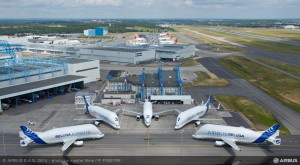
Dassault Falcon Jet Breaks Ground on Little Rock Expansion
September 2, 2014
New Hangars Dedicated to Completion of New Falcon 5X and Falcon 8X
September 2, 2014 (Little Rock, Arkansas): Dassault Falcon Jet broke ground today on a major expansion and upgrade of its Little Rock, Arkansas completion facility dedicated to two new models, the Falcon 5X very large body twin jet and ultra-long range Falcon 8X trijet. Introduced in October 2013 and May 2014 respectively, the new models will significantly expand the Falcon fleet and meet customer demand for additional range and cabin space.

Successful test-flights for Israel Aerospace Industries’ B767 Tanker using an advanced Fly-by-Wire (FBW) boom system
August 26, 2014
August 26th, 2014– Israel Aerospace Industries (IAI) recently performed successful test-flights on a B767-300ER aircraft, equipped with an advanced Fly-by-Wire (FBW) boom system. The new added FBW boom capability, for this specific type of aircraft, joins and enhances the company’s extensive experience in converting tens of aircraft (B767, B707, C130, and IL-78) to tankers or multi mission tanker/transport (MMTT) platforms, for more than 12 customers worldwide, including the Israel Air Force (IAF).
�
IAI’s innovative concept is based on conversion of pre-owned 767 passenger aircraft .The low utilization rate of MMTT platforms compared to commercial passenger aircraft translates into a continued long-term service life at a considerably lower Life Cycle Cost than for new aircraft. As part of the conversion a major part of the structure, wiring and systems are replaced, upgraded or refurbished. New engines, new military avionics including a state-of-the-art glass cockpit and new self-protection systems can also be offered, tailored to the customer’s specific requirements. The operational and technological experience gained from IAF and IAI’s other customers has been taken into consideration and utilized in the design and development of the new generation B767-300ER MMTT.
�
An IAI B767-200ER MMTT has been converted for the Colombian Air Force (CAF) and is performing successfully in all CAF support missions which include: air-refueling, troop and cargo transport, and presidential (VIP) transport worldwide. From 2012-2013, the B767 MMTT performed successfully in the US Red Flag, Canadian Maple Flag and Brazilian Cruzex exercises.
�
IAI is currently also offering MMTT platforms based on converted B767-300ER. This version, with over 400,000 lbs MTOW, can carry over 200,000 lbs. of fuel, additional troops and extra cargo pallets. IAI is continuously looking at improving and upgrading its Tanker/Transport aircraft and can offer a “Smart Tanker” version which performs additional tasks while in the air, such as: ELINT, SIGINT, and ESM, or serve as a communications hub or as a Command & Control post.
In the picture: IAI’s Bedek Aviation Group’s B767 during a FBW boom system test-flight
Beechcraft delivers T-6C+ trainers, King Air 350ER to Mexican Navy
August 21, 2014
Navy Secretaría de Marina (SEMAR), as well as one King Air 350ER, the second of four on order, as part of the Mexican Navy’s ongoing fixed-wing aircraft modernization program.
“Being chosen by the Mexican Navy for this modernization program shows a superior level of confidence not only in Beechcraft products to fill its mission requirements, but in the product support we’ll provide as part of the agreement,” said Russ Bartlett, president, Beechcraft Defense Company. “This is a great example of how militaries around the globe can take advantage of the broad product range and support that Textron Aviation can provide to meet different requirements.”
Bartlett also lauded the cooperation between SEMAR officials and the company in moving so swiftly from the T-6C+ contract award in March to delivery this month.
The newly delivered King Air is part of a four-aircraft contract signed earlier this year. The first King Air 350ER was delivered just a few months ago, and the remaining aircraft are expected to be delivered by early 2015. In addition to the aircraft, both contracts with SEMAR include parts support as well as training for pilots and mechanics.
The T-6C+ features a hard-point wing, Heads-Up Display, Up-Front Control Panel, an integrated glass cockpit and an advanced Esterline CMC Cockpit 4000 avionics suite that greatly expands advanced training opportunities. The systems are integrated with a Hands-On Throttle and Stick (HOTAS), providing the student pilot and instructor with a simpler interface to the digital cockpit. The open architecture design of the Cockpit 4000 provides the flexibility to expand capabilities and continuously meet current and future training needs.
The Beechcraft T-6 military training fleet has surpassed 850 aircraft worldwide with more than 2.5 million flight hours. The T-6 military trainer offers military operators worldwide the most proven and cost-effective primary aviation training system available today. Aircraft deliveries began in 2000 after the T-6 was selected to fill the Joint Primary Aircraft Training System role for the U.S. Air Force and the U.S. Navy. Since then, additional military customers worldwide have selected the T-6, including the NATO Flying Training in Canada Program, the Hellenic Air Force of Greece, the Israeli Air Force, the Iraqi Air Force, the Royal Moroccan Air Force, the Royal New Zealand Air Force, the Mexican Air Force and the Mexican Navy.
King Air turboprops, which operate commercially and in all branches of the U.S. military, serve a variety of missions ranging from traditional passenger and cargo transport to electronic and imagery surveillance, air ambulance, airway calibration, photographic mapping, training and weather modification. The global fleet recently surpassed 60 million flight hours.
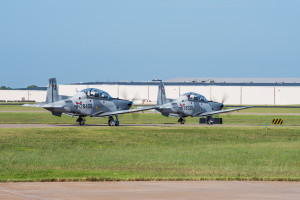
�
�
�
�
�
�
�
�
�
Jato executivo Legacy 500 recebe certificação da ANAC
August 12, 2014
São José dos Campos – SP, 12 de agosto de 2014 – A Agência Nacional de Aviação Civil (ANAC) entregou hoje o certificado de tipo do jato executivo Legacy 500 durante cerimônia na Latin American Business Aviation Conference and Exhibition (LABACE), em São Paulo. A Embraer espera receber certificação da FAA (Federal Aviation Administration), autoridade aeronáutica dos Estados Unidos, nas próximas semanas e em seguida a certificação da EASA (European Aviation Safety Agency), responsável pela homologação na Europa.
“Estamos muito satisfeitos com a conquista da certificação do Legacy 500, um jato revolucionário que traz a verdadeira inovação para nossos clientes”, disse Frederico Fleury Curado, Diretor-Presidente da Embraer. “Eu quero parabenizar as nossas equipes pela paixão e empenho para trazer ao mercado esta aeronave extraordinária.”
O programa de ensaios em voo foi composto de quatro protótipos que realizaram extensa campanha para avaliar o funcionamento e a confiabilidade de todos os sistemas e equipamentos. A frota de ensaio do Legacy 500 realizou mais de 1.800 horas de voo. Mais de 20.000 horas de testes foram conduzidas em laboratórios, equipados com bancadas de integração dos sistemas aviônicos, elétricos, hidráulicos e ambientais.
A produção em série do Legacy 500 já foi iniciada e a primeira entrega está prevista para setembro. Até seis aeronaves serão fabricadas em 2014 e o aumento da produção vai ocorrer ao longo de 2015.
“Estamos especialmente honrados com a confimação de que todos os requisitos de projeto do Legacy 500 foram alcançados ou superados”, disse Marco Túlio Pellegrini, Presidente da Embraer Aviação Executiva. “Esta aeronave é revolucionária. Com maior alcance e melhor desempenho de pista do que originalmente esperado, o Legacy 500 define um novo padrão para a categoria midsize”.
Cessna Citation M2 receives certifications in Brazil and Argentina, makes LABACE debut
August 12, 2014
SÃO PAULO, Brazil, Aug. 12, 2014– Cessna Aircraft Company, a subsidiary of Textron Aviation, a Textron Inc. (NYSE: TXT) company, announced today at the Latin American Business Aviation Conference & Exhibition that that Citation M2 – making its LABACE debut – has gained final certification from civil aviation authorities in Brazil and Argentina, paving the way for deliveries to begin.
Since its certification from the U.S. Federal Aviation Administration in December and European Aviation Safety Agency in June, 31 Citation M2s have been delivered to customers through the first half of this year.
“The market in Latin America has shown tremendous interest in the Citation M2 due to its competitive acquisition and operating costs, its airport performance and its advanced onboard systems,” said Robert Gibbs, vice president, International Sales.
The Citation M2 has a maximum cruise speed of 404 knots true airspeed (460 miles per hour) and a range of 1,580 nautical miles. It can operate at airports with runways as short as 3,210 feet and will climb to 41,000 feet in 24 minutes. The Citation M2 is certified for single-pilot operation with room for seven passengers and features two Williams FJ44 engines.
The Citation M2’s clean cockpit design features Cessna’s proprietary Intrinzic™ flight deck powered by Garmin G3000 avionics, with high-resolution multifunction displays and split-screen capability. Touch-screen interactivity comparable to a smartphone provides pilots with precise performance information they need in a logical, familiar user interface. From the cockpit divider aft through the rear lavatory, the main passenger cabin of the Citation M2 is 58 inches wide and 11 feet long with a 5-inch dropped aisle providing a cabin height of 57 inches. Eight large windows, roomy adjustable seats and intuitive controls highlight the all-new cabin.
This announcement is another demonstration of the company’s continued efforts to invest in products that meet the needs of global customers. New Citation products expected to come to market within the coming year include the recent certification of the Citation X+ and upcoming introductions of the Citation CJ3+ and Citation Latitude.
More than 6,600 Citations have been delivered to customers around the world since the first Cessna Citation business jet was put into service in 1972. Citations are the largest fleet of business jets in the world and have surpassed 30 million flight hours.


